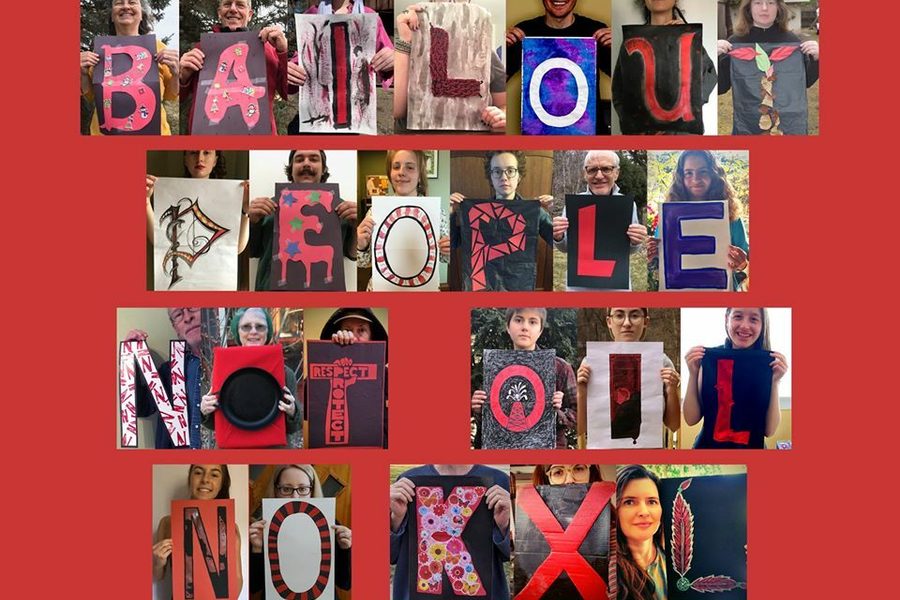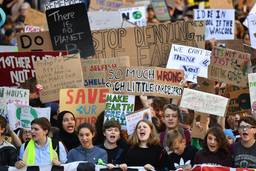This Crisis Can Be a Gateway to Climate Action. These Activists Are Showing How.
Climate justice organizers have moved from the streets to the Internet, where they are trying to scale up the fight.
Christine MacDonald

As the COVID-19 pandemic has left most of the country sheltering in place and bracing for hundreds of thousands of deaths and economic fallout that could sideline as much as a third of the U.S. workforce, climate justice warriors took to the Internet this past week to build an online mass movement that they are constructing as they go.
Propelled by anger over the $500 billion “corporate slush fund” included in the $2 trillion bailout rushed through Congress and signed by President Donald Trump last month, hundreds of environmental and social justice organizations have joined forces to demand that the next economic stimulus package Congress is expected to pass prioritize regular people over corporations and invest in long-term fixes to poverty and climate change.
“Mother Nature is fighting back,” said Jennifer Falcon, communications coordinator for the Indigenous Environmental Network. “Our response to climate change should be similar to our response to Covid-19, because after the pandemic passes, we are still facing a climate crisis and chaos is hitting communities from the arctic to the global south.”
The Network is among the organizations — from environmental stalwarts like Greenpeace, the Sunrise Movement and 350.org to progressive groups like the Working Families Party — that have rallied around proposals for a social-justice-infused People’s Bailout that would address the climate crisis with a clean energy transition, rather than propping up the failing oil and gas industry and other polluting corporations. The groups also support a detailed Green Stimulus plan, penned by progressive economic and policy experts and guided by five people-centric principals, including one that calls on the pandemic response to build “a regenerative economy” fueled by wind and solar.
Since the pandemic has forced activists to cancel planned Earth Day street protests this spring, climate and social justice organizations nationwide are scrambling to move online the fight for a just and renewable future. While the focus of the protests planned for Earth Day had been on climate justice, COVID-19 has exposed the woeful inadequacy, activists say, of the country’s healthcare and economic infrastructure, making the pandemic another strong argument for a more holistic approach to dealing with the country’s thorniest problems, from crumbling infrastructure to atrophied social safety nets, with proposals like the Green New Deal championed by Sunrise and many of the other groups.
The last year or so had already seen unprecedented increases in public concern about climate change, and support is on the rise for a comprehensive solution, such as the Green New Deal. Since the pandemic took hold, even more moderate environmental groups like the Ceres Investor Network and the Natural Resources Defense Council, more closely aligned with corporations than social justice organizations, are also demanding a climate-friendly U.S. government pandemic response to jumpstart a lower pollution future. Fatih Birol, executive director of the International Energy Agency, also made a plea last month for governments to use pandemic economic stimulus funding to prioritize the many shovel-ready clean and renewable energy projects that could set the world on a path to lower climate changing emissions.
The environmental movement has long been criticized for failing to fight for working people, particularly people of color. For decades those criticisms had made it too easy for corporations to pit labor unions and low-income communities against environmentalists. Those divisions have started dissolving in recent years, however, as labor unions and environmentalists find more common ground around battles for a “just climate transition.” This demand is aimed at addressing longstanding inequities in frontline communities and providing retraining and a jobs guarantee to shield workers as old economy industries such as oil and gas and coal fall by the waysides.
As traditional boundaries blur between activism on environmental and social justice, and the ranks of environmental justice activists grow, today’s youth-powered climate movement is giving this trend a turbo-boost. Much has been made of how these impassioned teenaged and young-adult activists are “digital natives,” savvy to the ways of online communicating. But they are “climate justice natives” too, who see the people’s and the planet’s troubles as inexorably linked — and reject the cliché that we must choose between protecting the economy or the environment.
While the rising death and economic tolls initially threw many climate justice groups back on their heels, Carrie Ramirez, an 18-year-old activist and college freshman, thinks some of the government and corporate responses to the pandemic are providing graphic illustrations of the types of injustices faced daily by frontline communities. She’s a member of the San Francisco area climate justice organization, Youth vs. Apocalypse, that visits primary schools in the Bay Area to talk about environmental justice, a topic she thinks has always been hard for the middle- and high-school students to visualize.
“A lot more people are seeing how systemic injustice really takes place and how our lives are [seen as] disposable. So it’s a really big moment of radicalization for a lot of people, who weren’t even aware of it earlier,” she said in a phone interview from her San Francisco apartment, where she’s sheltering in place.
Rather than fear that the pandemic could siphon away growing support for climate justice, Ramirez says, “We are building momentum because a lot more people are seeing how this pandemic is effecting low income communities. So, if anything, we are not afraid of losing momentum. We’re just figuring out, like everyone else, how we’re going to transition from meeting in person to meeting online.”
Ramirez’s group is among more than 800 backing the People’s Bailout. Thousands of people around the country tuned into the Working Families Party’s Facebook page this week to attend virtual rallies and teach-ins. Those and other online initiatives, such as Zero Hour’s “Getting to the Roots of Climate Change” online campaign launched Monday, aim to inspire activists to kick online action into higher gear and tie today’s pandemic into the case for systemic change.
“Millions of young people are at home with nothing to do,” said Evan Weber, the Sunrise co-founder and political director. “It’s a huge opportunity to capture interest and do something meaningful and productive.”
The youth climate organization held its own hour-long video call last Sunday that was part group bonding in the times of the coronavirus, part recruitment call for Sunrise School, its organizing 101 course that the group hastily adapted to the new pandemic and online realities. Weber said more than 6,000 people signed up for the online version of the four-day organizing workshop, 10 times as many as they had expected. A teenager named Gretchen, who was one of thousands who attended the online Sunrise School last month, told the hundreds of activists on a Zoom call last Sunday, that getting involved had helped her shift “the fear lodged in my throat” about the pandemic.
“Democrats have a clear choice to make: Bail out corporations and leave working people behind or invest in people and our infrastructure that’s proved woefully inadequate,” Sunrise’s legislative manager, Lauren Maunus, told activists on the group’s Zoom call Sunday night, laying out the plan to push Joe Biden and party leaders to support progressive positions on issues such as the People’s Bailout, the Green Stimulus plan and the Green New Deal.
The unfolding of a pandemic during a presidential election year has further ratchetted up the stakes. Climate change was a major primary campaign issue among Democratic contenders. But with Sen. Bernie Sanders’ campaign in limbo, some pundits now speculate that former Vice President Joe Biden, the presumed Democratic nominee, can now safely minimize his attention to climate change, an issue he never seemed comfortable with as a policy priority. That is one possibility the Sunrise Movement is girding against. Part of its push to recruit and train activists during the pandemic lockdowns aims to keep up the pressure for a Green New Deal, the group says is the only proposal comprehensive enough to confront the multidimensional dangers of climate change.
Sunrise, which has started endorsing political candidates, saw a couple of its congressional favorites win in state primaries this winter, even as the group’s presidential pick, Bernie Sanders, hasn’t fared so well. The group will fight hard to defeat Trump in November regardless of whether Biden secures the Democratic nomination, but will use its growing political clout to keep on pushing for a Green New Deal, said Evan Weber, the Sunrise co-founder and political director.
“One of the reasons we launched [Sunrise] was that the environmental movement was not taking political power seriously enough,” beyond supporting any Democratic candidate, he said. “A lot of groups had confused access with actual power” and prioritize relationships on Capitol Hill over accountability, he underscored.
Organizations, like Sunrise, Working Families Party, 350.org, and others pushing for a Green New Deal, have said all along that the fight will continue beyond the November election, but they are trying to make the best use of time now, while most people in the country are forced to stay at home to combat the spread of the virus. Last Sunday’s People’s Bailout action, for example, sent the message that the people will not accept more corporate bailouts, said Anthony Rogers-Wright of the Climate Justice Alliance. With so many people stuck at home right now, he says it’ll be all the easier for them to flex “the power of the people, albeit in a digital format.”
Andrew J. Hoffman, a business professor at University of Michigan who studies society’s views of climate change, called the pandemic “a test of the resiliency of our institutions” and of ourselves and how each of us will react to the climate challenges ahead. So far, he says, it’s been a mixed bag of partisan sniping and self-interested panic shopping. But “on the flip side,” he argues, “we’ve had tremendous giving and cooperation. … That should give us some hope that we can deal with climate change.”
“We do have to face facts that the world is changing,” he said. “We need to develop resilient systems prepared for the kind of challenge that corona has presented us and others that we haven’t thought through.”
He thinks linking the pandemic to climate change risks setting off a backlash, particularly among climate change deniers, but notes that U.S. views on climate change are undeniably changing. “In the past five years, the number of people who believe climate change is real and human-caused has been going up steadily even among moderate to liberal Republicans….This is a shift that has already taken place,” he says. “The partisan divide is narrowing.”
Nevertheless, public opinion isn’t changing fast enough, considering that climate scientists say there’s less than a decade left to reduce climate changing fossil fuel emissions and ensure the planet doesn’t warm more than the 1.5 degrees Celsius that is critical to avoid natural tipping points that threaten life as we know it. And while more Republicans may believe in climate change today than a year ago, the fight for more people-centered bailouts and climate policies is going to be as fiercely waged online as it would be in person, as was previewed in last month’s Washington wrangling.
Democrats in Congress blocked a bailout for oil and gas companies from inclusion in the $2 trillion stimulus package last month, but Republics nixed proposed support for the wind and solar industries and prevented tying the $50 billion channeled to airline industry to more ambitious reductions in airline emissions. The intense backroom lobbying continues, as both sides gird for the next stimulus package battle. While most people are focused on the COVID-19 crisis, the Trump administration has continued rolling back the country’s environmental protections. In a sign that supporters of the old fossil fuel economy are using the shock of the pandemic to prepare for future fights, three states just outlawed in-person protesting at oil and gas installations.
But can online activism replace people in the streets in this crucial year for climate action? Will it limit the involvement of vulnerable communities, which are less likely to have Internet at home? Falcon from the Indigenous Environmental Network says radio and podcasts have proved more effective particularly on reservations and remote indigenous communities where Internet access is limited and expensive.
Bill McKibben, 350.org cofounder, worries that online actions make it harder to attract new people to the movement. “You have to work hard to make sure that you don’t just default to the already engaged,” he says.
He’s also not so sure whether most people will equate the pandemic as one more reason for the sweeping systemic changes 350.org, Sunrise and other groups are pushing for. “I’d settle for people deciding that reality is real, and can bite us hard,” he wrote in an email. “Clearly the virus is making this point about biology; climate change requires that we take physics and chemistry with similar seriousness.”
Despite the current moment’s risks, Rogers-Wright of the Climate Justice Alliance also sees uniquely powerful opportunities online to broaden the movement’s base. “It’s really one of our only choices right now, so how do we use the time to reshape the narrative for everything that we want?”
Online campaigns, he points out, can reach more of the country and develop new local leaders using the same online targeting tactics advertisers use to build a diverse grassroots movement across the country.
“We’ve had three people’s climate marches and the climate crisis has gotten even worse,” he points out. “So if we can use this moment to recapture the narrative and go on offense with our narrative that’s in itself would be a tremendous win.”
Christine MacDonald is an investigative reporter and author, whose work focuses climate change, environmental sustainability and greenwashing. She was a 2019-2020 fellow with the Leonard C. Goodman Institute for Investigative Reporting.








